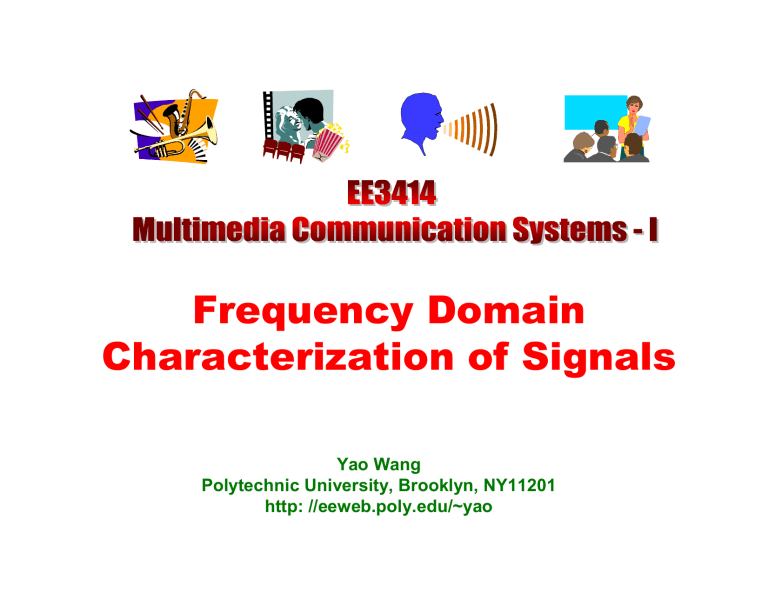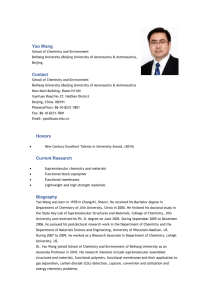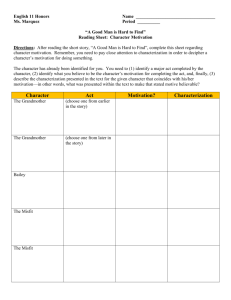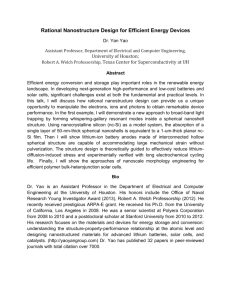Frequency Domain Characterization of Signals Yao Wang Polytechnic University, Brooklyn, NY11201

Frequency Domain
Characterization of Signals
Yao Wang
Polytechnic University, Brooklyn, NY11201 http: //eeweb.poly.edu/~yao
Signal Representation
• What is a signal
• Time-domain description
– Waveform representation
– Periodic vs. non-periodic signals
• Frequency-domain description
– Periodic signals
– Sinusoidal signals
– Fourier series for periodic signals
– Fourier transform for non-periodic signals
– Concepts of frequency, bandwidth, filtering
– Numerical calculation: FFT, spectrogram
– Demo: real sounds and their spectrogram (from DSP First)
©Yao Wang, 2006 EE3414: Signal Characterization 2
What is a signal
• A variable (or multiple variables) that changes in time
– Speech or audio signal: A sound amplitude that varies in time
– Temperature readings at different hours of a day
– Stock price changes over days
– Etc …
• More generally, a signal may vary in 2-D space and/or time
– A picture: the color varies in a 2-D space
– A video sequence: the color varies in 2-D space and in time
• Continuous vs. Discrete
– The value can vary continuously or take from a discrete set
– The time and space can also be continuous or discrete
– We will look at continuous-time signal only in this lecture
©Yao Wang, 2006 EE3414: Signal Characterization 3
Waveform Representation
• Waveform representation
– Plot of the variable value (sound amplitude, temperature reading, stock price) vs. time
– Mathematical representation: s(t)
©Yao Wang, 2006 EE3414: Signal Characterization 4
Sample Speech Waveform
0.08
0.06
0.04
0.02
0
-0.02
-0.04
0.08
0.06
0.04
0.02
0
-0.02
-0.04
-0.06
-0.06
-0.08
-0.1
0 2000 4000 6000 8000 10000 12000 14000 16000
Entire waveform
-0.08
-0.1
2000 2200 2400 2600
Blown-up of a section.
» [y,fs]=wavread('morning.wav');
» sound(y,fs);
» figure; plot(y);
» x=y(10000:25000);plot(x);
2800
» figure; plot(x);
» axis([2000,3000,-0.1,0.08]);
Signal within each short time interval is periodic
Period depends on the vowel being spoken
3000
©Yao Wang, 2006 EE3414: Signal Characterization 5
Sample Music Waveform
Entire waveform Blown-up of a section
» [y,fs]=wavread(’sc01_L.wav');
» sound(y,fs);
» figure; plot(y);
» v=axis;
» axis([1.1e4,1.2e4,-.2,.2])
Music typically has more periodic structure than speech
Structure depends on the note being played
©Yao Wang, 2006 EE3414: Signal Characterization 6
Sinusoidal Signals
s ( t )
=
A cos( 2
π f
0 t
+ φ
) f
0
: frequency
(cycles/se cond)
T
0
=
1 / f
0
: period
A
φ
: Amplitude
: Phase (time shift)
0.5
0
-0.5
2.5
2
1.5
1
-1
-1.5
-2
-2.5
-1.5
-1 -0.5
0 0.5
1
• Sinusoidal signals are important because they can be used to synthesize any signal
– An arbitrary signal can be expressed as a sum of many sinusoidal signals with different frequencies, amplitudes and phases
• Music notes are essentially sinusoids at different frequencies
1.5
©Yao Wang, 2006 EE3414: Signal Characterization 7
What is frequency of an arbitrary signal?
• Sinusoidal signals have a distinct (unique) frequency
• An arbitrary signal does not have a unique frequency, but can be decomposed into many sinusoidal signals with different frequencies, each with different magnitude and phase
• The spectrum of a signal refers to the plot of the magnitudes and phases of different frequency components
• The bandwidth of a signal is the spread of the frequency components with significant energy existing in a signal
• Fourier series and Fourier transform are ways to find spectrums for periodic and aperiodic signals, respectively
©Yao Wang, 2006 EE3414: Signal Characterization 8
Approximation of Periodic Signals by Sum of Sinusoids
2 sinusoids: 1 st and 3d harmonics
1
0.5
0 s ( t )
= k
∞
∑
=
0
A k cos( 2
π kf
0 t )
-0.5
-1
-1.5
View note for matlab code
-1 -0.5
0 0.5
1 1.5
4 sinusoids: 1,3,5,7 harmonics
With many more sinusoids with appropriate magnitude, we will get the square wave exactly
©Yao Wang, 2006 EE3414: Signal Characterization 9
Line Spectrum of Square Wave
Magnitude Spectrum for Square Wave
1.4
1.2
1
0.8
0.6
0.4
0.2
0
1
A k
=
4
π
0 k k
=
1 , 3 , 5 ,...
k
=
0 , 2 , 4 ,...
3
©Yao Wang, 2006
5 7 k,f k
=f
0
*k
9 11 13 15
EE3414: Signal Characterization
Each line corresponds to one harmonic frequency. The line magnitude (height) indicates the contribution of that frequency to the signal.
The line magnitude drops exponentially, which is not very fast. The very sharp transition in square waves calls for very high frequency sinusoids to synthesize.
10
Period Signal
• Period T : The minimum interval on which a signal repeats
– Sketch on board
• Fundamental frequency : f
0
=1/T
• Harmonic frequencies : kf
0
©Yao Wang, 2006 EE3414: Signal Characterization 11
Approximation of Periodic Signals by
Sinusoids
• Any periodic signal can be approximated by a sum of many sinusoids at harmonic frequencies of the signal
( kf
0
) with appropriate amplitude and phase.
• The more harmonic components are added, the more accurate the approximation becomes.
• Instead of using sinusoidal signals, mathematically, we can use the complex exponential functions with both positive and negative harmonic frequencies
12 ©Yao Wang, 2006 EE3414: Signal Characterization
Complex Exponential Signals
• Complex number:
A
=
A exp( j
φ
)
=
A cos
φ + j A sin
φ =
Re
+ j Im
• Complex exponential signal s ( t )
=
A exp( j 2
π f
0 t )
=
A cos( 2
π f
0 t
+ φ
)
+ j A sin( 2
π f
0 t
+ φ
)
• Euler formula exp( exp( j
ω t ) j
ω t )
+ exp(
−
− exp(
− j
ω t ) j
ω t )
=
=
2 cos(
ω t ) j 2 sin(
ω t )
©Yao Wang, 2006 EE3414: Signal Characterization 13
Fourier Series Representation of
Periodic Signals
Fourier Series Synthesis (inverse transform ) : s ( t )
=
=
A
0
+ k
∞
∑
=
1 k
=
∞
∑
−∞
S k
A k exp( cos( 2
π kf
0 t j 2
π kf
0 t )
+ φ k
) ( single sided, for real signal only)
(double sided, for both real and complex)
Fourier series analysis (forward transform ) :
S k
=
1
T
0
∫
0
T
0 s ( t ) exp(
− j 2
π kf
0 t ) dt ; k
=
0 ,
±
1 , 2 ,...
S k is in general a complex number
For real signals, S k
=S *
-k
|S k
|=|S
-k
| (Symmetric spectrum)
©Yao Wang, 2006 EE3414: Signal Characterization 14
Fourier Series Representation of
Square Wave
• Applying the Fourier series analysis formula to the square wave, we get
S k
=
2 j
π k
0 k
= ±
1 , 3 , 5 ,...
k
=
0 ,
±
2 , 4 ,...
• Do the derivation on the board
©Yao Wang, 2006 EE3414: Signal Characterization 15
Line Spectrum of Square Wave
Magnitude Spectrum for Square Wave
1.4
1.2
1
0.8
0.6
0.4
0.2
0
1
A k
=
4
π
0 k k
=
1 , 3 , 5 ,...
k
=
0 , 2 , 4 ,...
3
©Yao Wang, 2006
5 7 k,f k
=f
0
*k
9 11 13 15
EE3414: Signal Characterization
Only the positive frequency side is drawn on the left
(single sided spectrum), with twice the magnitude of the double sided spectrum.
16
Fourier Transform for Non-Periodic
Signals
Aperiodic signal
→
T
0
= ∞
→ integral instead of sum
→ f
0
=
0
→ uncountabl e number of harmonics
Fourier synthesis (inverse transform ) : s ( t )
=
−
∞
∫
∞
S ( f ) exp( j 2
π ft ) df
Fourier analysis (forward transform ) :
S(f)
=
−
∞
∫
∞ s ( t ) exp(
− j 2
π ft ) dt
For real signals, | S(f)| =|S(-f)| (Symmetric magnitude spectrum)
©Yao Wang, 2006 EE3414: Signal Characterization 17
Pulse Function: Time Domain
A Rectangular Pulse Function
1.2
1
0.8
0.6
0.4
0.2
T
0
-1 -0.8
-0.6
-0.4
-0.2
t
0 0.2
0.4
0.6
0.8
1
©Yao Wang, 2006
Derive Fourier transform on the board
EE3414: Signal Characterization s ( t )
=
1
0
−
T / 2
< t
<
T / 2 otherwise
18
Pulse Function: Spectrum
Magnitude Spectrum of Rectangular Pulse
1.2
1
0.8
0.6
0.4
0.2
The peaks of the FT magnitude drops slowly.
This is because the pulse function has sharp transition, which contributes to very high frequency in the signal.
0
-0.2
-0.4
-10 -8 s ( t )
=
1
0
-6 -4 -2 f
0
−
T / 2
< t
<
T / 2 otherwise
©Yao Wang, 2006
2
⇔
S (
4 f )
=
6
T sin(
π
8
π
Tf
Tf
EE3414: Signal Characterization
10
)
=
T sinc( Tf )
19
Exponential Decay: Time Domain
1
0.9
0.8
0.7
0.6
0.5
0.4
0.3
0.2
0.1
s(t)=exp(-
α
t), t>0);
α
=1
0
0 0.5
s ( t )
=
exp(
0
− α t )
1 1.5
t
>
0 otherwise
2
⇔
2.5
t
3 3.5
4 4.5
S ( f )
=
α +
1 j 2
π f
; S ( f )
=
5
1
α 2 +
4
π 2 f
2
©Yao Wang, 2006 EE3414: Signal Characterization 20
Exponential Decay: Spectrum
0.5
0.4
0.3
0.2
0.1
0
-10
1
0.9
0.8
0.7
0.6
S(f)=1/(
α
+j 2
π
f),
α
=1
The FT magnitude drops much faster than for the pulse function. This is because the exponential decay function does not has sharp transition.
-8 -6 -4 -2 s ( t )
=
exp(
0
− α t ) t
>
0 otherwise f
0 2 4 6 8 10
⇔
S ( f )
=
α +
1 j 2
π f
; S ( f )
=
α 2
1
+
4
π 2 f
2
©Yao Wang, 2006 EE3414: Signal Characterization 21
(Effective) Bandwidth
1
0.9
0.8
0.7
0.6
0.5
0.4
0.3
0.2
0.1
0
-10 -8
B
-6 -4
©Yao Wang, 2006
-2 0 2 4 6 8 f min f max
EE3414: Signal Characterization
10
• f min
( f ma
): lowest
(highest) frequency where the FT magnitude is above a threshold
• Bandwidth:
B=f max
-f min
• The threshold is often chosen with respect to the peak magnitude, expressed in dB
• dB=10 log10(ratio)
• 10 dB below peak =
1/10 of the peak value
• 3 dB below=1/2 of the peak
22
More on Bandwidth
• Bandwidth of a signal is a critical feature when dealing with the transmission of this signal
• A communication channel usually operates only at certain frequency range (called channel bandwidth)
– The signal will be severely attenuated if it contains frequencies outside the range of the channel bandwidth
– To carry a signal in a channel, the signal needed to be modulated from its baseband to the channel bandwidth
– Multiple narrowband signals may be multiplexed to use a single wideband channel
©Yao Wang, 2006 EE3414: Signal Characterization 23
How to Observe Frequency Content from Waveforms?
• A constant -> only zero frequency component (DC compoent)
• A sinusoid -> Contain only a single frequency component
• Periodic signals -> Contain the fundamental frequency and harmonics -> Line spectrum
• Slowly varying -> contain low frequency only
• Fast varying -> contain very high frequency
• Sharp transition -> contain from low to high frequency
• Music: contain both slowly varying and fast varying components, wide bandwidth
• Highest frequency estimation?
– Find the shortest interval between peak and valleys
• Go through examples on the board
©Yao Wang, 2006 EE3414: Signal Characterization 24
Estimation of Maximum Frequency
Blown-Up of the Signal
S(t)
0.04
0.03
0.02
0.01
0
-0.01
©Yao Wang, 2006
-0.02
2450 2460 2470 2480 2490 2500 2510 2520 2530 2540 2550
Time index
EE3414: Signal Characterization 25
Numerical Calculation of FT
• The original signal is digitized, and then a Fast
Fourier Transform (FFT) algorithm is applied, which yields samples of the FT at equally spaced intervals.
• For a signal that is very long, e.g. a speech signal or a music piece, spectrogram is used.
– Fourier transforms over successive overlapping short intervals
©Yao Wang, 2006 EE3414: Signal Characterization 26
Spectrogram
S(t)
0.08
0.06
0.04
0.02
0
-0.02
-0.04
-0.06
-0.08
-0.1
2000
FFT
2200
FFT
2400
FFT
©Yao Wang, 2006
FFT
2600
EE3414: Signal Characterization
FFT
2800
FFT
3000 t
27
Sample Speech Waveform
(click to hear the sound)
0.08
0.06
0.04
0.02
0
-0.02
-0.04
0.08
0.06
0.04
0.02
-0.06
-0.08
-0.1
0 2000 4000 6000 8000 10000 12000 14000 16000
Entire waveform
0
-0.02
-0.04
-0.06
-0.08
T
-0.1
2000 2200 2400 2600
Blown-up of a section.
2800 3000
Signal within each short time interval is periodic. The period T is called “pitch”.
The pitch depends on the vowel being spoken, changes in time. T~70 samples in this ex. f
0
=1/T is the fundamental frequency (also known as formant frequency).
k * f
0
( k =integers) are the harmonic frequencies.
f
0
=1/70fs=315 Hz.
©Yao Wang, 2006 EE3414: Signal Characterization 28
Sample Speech Spectrogram
-15
-20
-25
-30
-35
-40
-45
-50
-55
-60
0 f
0
2000
» figure;
» psd(x,256,fs);
Power Spectrum
4000 6000
Frequency
8000 fs=22,050Hz
10000 12000
1
0.9
0.8
0.7
0.6
0.5
0.4
0.3
0.2
f
0
0.1
0
0
Spectrogram
GOOD MOR NING
1000 2000 3000 4000
Time
5000 6000 7000
» figure;
» specgram(x,256,fs);
Signal power drops sharply at about 4KHz
©Yao Wang, 2006
Line spectra at multiple of f0, maximum frequency about 4 KHz
What determines the maximum freq?
EE3414: Signal Characterization 29
Another Sample Speech Waveform
Entire waveform Blown-up of a section.
“In the course of a December tour in Yorkshire”
©Yao Wang, 2006 EE3414: Signal Characterization 30
Speech Spectrogram
» figure;
» psd(x,256,fs);
Signal power drops sharply at about 4KHz
©Yao Wang, 2006
» figure;
» specgram(x,256,fs);
Line spectra at multiple of f0, maximum frequency about 4 KHz
EE3414: Signal Characterization 31
Sample Music Waveform
Entire waveform Blown-up of a section
» [y,fs]=wavread(’sc01_L.wav');
» sound(y,fs);
» figure; plot(y);
» v=axis;
» axis([1.1e4,1.2e4,-.2,.2])
Music typically has more periodic structure than speech
Structure depends on the note being played
©Yao Wang, 2006 EE3414: Signal Characterization 32
Sample Music Spectrogram
» figure; » psd(y,256,fs);
Signal power drops gradually in the entire frequency range
©Yao Wang, 2006
» figure; » specgram(y,256,fs);
Line spectra are more stationary,
Frequencies above 4 KHz, more than
20KHz in this ex.
EE3414: Signal Characterization 33
Summary of Characteristics of Speech & Music
• Typical speech and music waveforms are semi-periodic
– The fundamental period is called pitch period
– The inverse of the pitch period is the fundamental frequency (f0)
• Spectral content
– Within each short segment, a speech or music signal can be decomposed into a pure sinusoidal component with frequency f0, and additional harmonic components with frequencies that are multiples of f0.
– The maximum frequency is usually several multiples of the fundamental frequency
– Speech has a frequency span up to 4 KHz
– Audio has a much wider spectrum, up to 22KHz
©Yao Wang, 2006 EE3414: Signal Characterization 34
Demo
• Demo in DSP First, Chapter 3, Sounds and
Spectrograms
– Look at the waveform and spectrogram of sample signals, while listening to the actual sound
– Simple sounds
– Real sounds
©Yao Wang, 2006 EE3414: Signal Characterization 35
Advantage of Frequency Domain
Representation
• Clearly shows the frequency composition of the signal
• One can change the magnitude of any frequency component arbitrarily by a filtering operation
– Lowpass -> smoothing, noise removal
– Highpass -> edge/transition detection
– High emphasis -> edge enhancement
• One can also shift the central frequency by modulation
– A core technique for communication, which uses modulation to multiplex many signals into a single composite signal, to be carried over the same physical medium.
©Yao Wang, 2006 EE3414: Signal Characterization 36
Typical Filters
• Lowpass -> smoothing, noise removal
• Highpass -> edge/transition detection
• Bandpass -> Retain only a certain frequency range
Low-pass
H(f)
High-pass
H(f)
Band-pass
H(f)
0
©Yao Wang, 2006 f 0 f
EE3414: Signal Characterization
0 f
37
Low Pass Filtering
(Remove high freq, make signal smoother)
1.2
1
0.8
0.6
0.4
0.2
0
-0.2
-0.4
-10 -8 -6
Magnitude Spectrum of Rectangular Pulse
Ideal lowpass filter
Spectrum of the pulse signal
Filtering is done by a simple multiplification:
Y(f)= X(f) H(f)
H(f) is designed to magnify or reduce the magnitude (and possibly change phase) of the original signal at different frequencies.
A pulse signal after low pass filtering (left) will have rounded corners.
-4 -2 f
0 2 4 6 8 10
©Yao Wang, 2006 EE3414: Signal Characterization 38
S(t)
The original pulse function and its low-passed versions
1.2
1
0.8
0.6
0.4
original averaging over 11 samples filter=fir1(10,0.25)
0.2
0
-0.2
-1 -0.8
-0.6
-0.4
-0.2
0 0.2
0.4
0.6
0.8
1 t
h(t)
Impulse Response of the Filters
0.3
0.25
0.2
0.15
0.1
0.05
0
-0.05
1 2 averaging over 11 samples fir1(10,0.25)
3 4 5 6 7 8 9 10 11 t
©Yao Wang, 2006 EE3414: Signal Characterization 40
Frequency Response of the Filters
Averaging fir11(10,0.25)
©Yao Wang, 2006
0
-20
-40
-60
-80
0 0.1
0.2
0.3
0.4
0.5
0.6
0.7
0.8
Normalized Angular Frequency ( ×π rads/sample)
0.9
100
0
0
-50
-100
-100
-200
0
-150
0
0
0.1
0.1
0.2
0.3
0.4
0.5
0.6
0.7
0.8
Normalized Angular Frequency (
0.2
0.3
0.4
0.5
×π rads/sample)
0.7
0.8
Normalized Angular Frequency ( ×π rads/sample)
EE3414: Signal Characterization
0.9
0.9
1
1
1
41
High Pass Filtering
(remove low freq, detect edges)
©Yao Wang, 2006
Magnitude Spectrum of Rectangular Pulse
0.6
0.4
0.2
1.2
1
0.8
0
-0.2
-0.4
-10 -8 -6 -4 -2 f
0
Ideal high-pass filter
2
Spectrum of the pulse signal
4 6 8 10
EE3414: Signal Characterization 42
The original pulse function and its high-passed version
S(t)
1
0.8
original high-pass filtered
0.6
0.4
0.2
0
-0.2
-0.4
-1 -0.8
-0.6
-0.4
-0.2
©Yao Wang, 2006
0 0.2
0.4
0.6
0.8
t
1
EE3414: Signal Characterization 43
The High Pass Filter
fir1(10,0.5,’high’);
Impulse response:
Current sample – neighboring samples
Frequency response
©Yao Wang, 2006 h(t)
0.2
0.1
0
-0.1
-0.2
-0.3
1
0.5
0.4
0.3
2 3 4 5 6 7 8 9 10 11 t
0
-20
-40
-60
-80
-100
0
400
0.1
0.2
0.3
0.4
0.5
0.6
0.7
0.8
Normalized Angular Frequency ( ×π rads/sample)
EE3414: Signal Characterization
0.9
1
44
Filtering in Temporal Domain
(Convolution)
• Convolution theorem
X ( f ) H ( f )
⇔ x ( t ) * h ( t ) x ( t ) * h ( t )
=
∞
∫
− ∞ x ( t
− τ
) h (
τ
) d
τ
• Interpretation of convolution operation
– replacing each pixel by a weighted sum of its neighbors
– Low-pass: the weights sum = weighted average
– High-pass: the weighted sum = left neighbors –right neighbors
©Yao Wang, 2006 EE3414: Signal Characterization 45
Implementation of Filtering
• Frequency Domain
– FT -> Filtering by multiplication with H(f) -> Inverse FT
• Time Domain
– Convolution using a filter h(t) (inverse FT of H(f))
• You should understand how to perform filtering in frequency domain, given a filter specified in frequency domain
• Should know the function of the filter given H(f)
• Computation of convolution is not required for this lecture
• Filter design is not required.
©Yao Wang, 2006 EE3414: Signal Characterization 46
What Should You Know (I)
• Sinusoid signals:
– Can determine the period, frequency, magnitude and phase of a sinusoid signal from a given formula or plot
• Fourier series for periodic signals
– Understand the meaning of Fourier series representation
– Can calculate the Fourier series coefficients for simple signals (only require double sided)
– Can sketch the line spectrum from the Fourier series coefficients
• Fourier transform for non-periodic signals
– Understand the meaning of the inverse Fourier transform
– Can calculate the Fourier transform for simple signals
– Can sketch the spectrum
– Can determine the bandwidth of the signal from its spectrum
– Know how to interpret a spectrogram plot
©Yao Wang, 2006 EE3414: Signal Characterization 47
What Should You Know (II)
• Speech and music signals
– Typical bandwidth for both
– Different patterns in the spectrogram
– Understand the connection between music notes and sinusoidal signals
• Filtering concept
– Know how to apply filtering in the frequency domain
– Can interpret the function of a filter based on its frequency response
• Lowpass -> smoothing, noise removal
• Highpass -> edge detection, differentiator
• Bandpass -> retain certain frequency band, useful for demodulation
©Yao Wang, 2006 EE3414: Signal Characterization 48
References
• Oppenheim and Wilsky, Signals and Systems, Sec. 4.2-4.3
(Fourier series and Fourier transform)
• McClellan, Schafer and Yoder, DSP First, Sec. 2.2,2.3,2.5
(review of sinusoidal signals, complex number, complex exponentials)
©Yao Wang, 2006 EE3414: Signal Characterization 49







